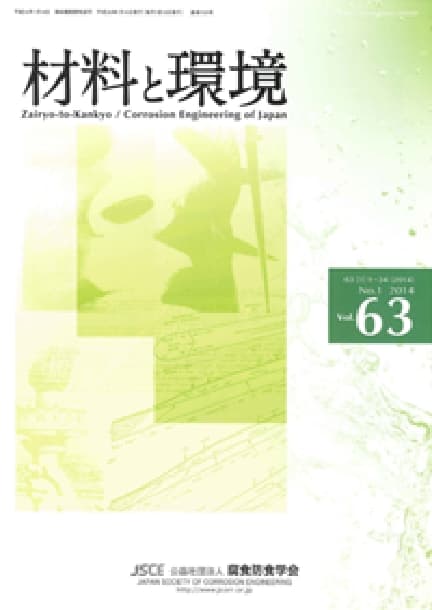- TOP
- Zairyo-to-Kankyo
- Vol. 69 (2020), No. 1
Zairyo-to-Kankyo Vol. 69 (2020), No. 1
Backnumber
-
Vol. 74 (2025)
-
Vol. 73 (2024)
-
Vol. 72 (2023)
-
Vol. 71 (2022)
-
Vol. 70 (2021)
-
Vol. 69 (2020)
-
Vol. 68 (2019)
-
Vol. 67 (2018)
-
Vol. 66 (2017)
-
Vol. 65 (2016)
-
Vol. 64 (2015)
-
Vol. 63 (2014)
-
Vol. 62 (2013)
-
Vol. 61 (2012)
-
Vol. 60 (2011)
-
Vol. 59 (2010)
-
Vol. 58 (2009)
-
Vol. 57 (2008)
-
Vol. 56 (2007)
-
Vol. 55 (2006)
-
Vol. 54 (2005)
-
Vol. 53 (2004)
-
Vol. 52 (2003)
-
Vol. 51 (2002)
-
Vol. 50 (2001)
-
Vol. 49 (2000)
-
Vol. 48 (1999)
-
Vol. 47 (1998)
-
Vol. 46 (1997)
-
Vol. 45 (1996)
-
Vol. 44 (1995)
-
Vol. 43 (1994)
-
Vol. 42 (1993)
-
Vol. 41 (1992)
-
Vol. 40 (1991)
Keyword Ranking
23 Nov. (Last 30 Days)
Zairyo-to-Kankyo Vol. 69 (2020), No. 1
Analysis on the Growth Mechanism of Corrosion Products of Copper Materials Containing Brass by Voltammetry
Shigeyoshi Nakayama, Aiko Tominaga, Hiroyuki Fujioka, Takenori Notoya, Toshiyuki Osakai
pp. 10-16
DOI:
10.3323/jcorr.69.10Abstract
Corrosion products on the brass surface were characterized by voltammetry with a high alkaline electrolyte solution (6 M KOH+1 M LiOH). In addition to copper oxides (Cu2O and CuO), zinc oxide (ZnO) was also confirmed on corroded brass surfaces. Depending on corrosion conditions, the amounts of the respective oxides formed on brass surfaces were varied. In the corrosion test in which brass is immersed in a NaCl solution (by assuming dezincification corrosion), Cu2O was selectively formed, and then grew significantly in NaCl solution at the concentration of 0.1% or less. However, when the concentration exceeded 1%, the formation of ZnO was newly confirmed. It was suggested that the formation and growth behaviors of the oxides on brass should be affected by the diffusion rate of zinc dependent on the concentration of NaCl solution.
Effect of Deposits on Corrosion of Copper Tubes in a Circulating Cooling Water System
Hidefumi Yamanaka, Tomoyuki Nagai, Hidemasa Nonaka, Hiroaki Tsuchiya, Shinji Fujimoto
pp. 17-25
DOI:
10.3323/jcorr.69.17Abstract
In the present study, possible effect of deposits on the corrosion of copper pipes in concentrated cooling water has been examined. It was considered that during the localized corrosion of copper pipes, the cathodic process took place on the intact sites of carbonaceous films, whereas the anodic process occurred on their defective sites. The deposits covering the defects of carbonaceous films significantly affected the corrosion of copper pipes. In particular, the presence of iron rust strongly enhanced the anodic reaction, resulting in severe corrosion. The enhanced anodic reaction was attributed to the suppressed formation of a protective oxide film most likely due to the lower pH of the areas located beneath the iron rust. It was suggested that the pretreatment to form a protective copper oxide film onto the copper pipe surface inhibited the corrosion process beneath the iron rust deposit.
Article Access Ranking
23 Nov. (Last 30 Days)
-
Perspectives on the Promising Pathways to Zero Carbon Emissions in the Steel Industry toward 2050
ISIJ International Vol.65(2025), No.2
-
Integrated Steelworks that Reduce CO2 Emissions by More Than 80% ─ Challenge for Carbon-Neutral Integrated Steelworks ─
Tetsu-to-Hagané Vol.111(2025), No.13
-
A new simulation characterization method to reveal the causes of cracking for cast iron cooling staves
ISIJ International Advance Publication
-
Advanced Coil Cooling Model Incorporating Layering and Interface Effects of Strip Windings
ISIJ International Vol.65(2025), No.11
-
Progress of Strip Casting Technology for Steel; Historical Developments
ISIJ International Vol.52(2012), No.12
-
Microstructures and Reduction Properties of High CaO Concentration Sintered Ore
ISIJ International Advance Publication
-
Development of New Cryogenic Steels for the Superconducting Magnets of the Fusion Experimental Reactor
ISIJ International Vol.30(1990), No.8
-
Effect of Baffles on the Mixing of Liquid and Particles in a Mechanically Stirred Vessel
Tetsu-to-Hagané Vol.90(2004), No.6
-
Steel Cleanness Evaluation: Framework for Inclusion Characterization by Means of Automated and Manual SEM/EDS Analysis and Computational Thermodynamics
ISIJ International Advance Publication
-
You can use this feature after you logged into the site.
Please click the button below.










